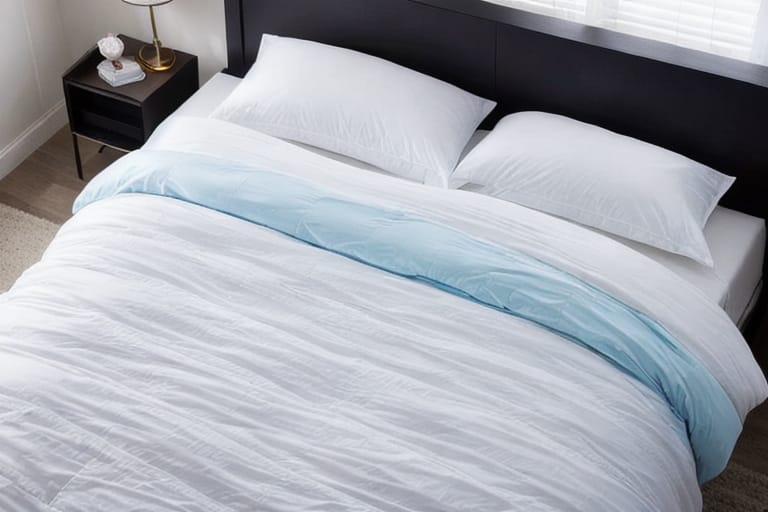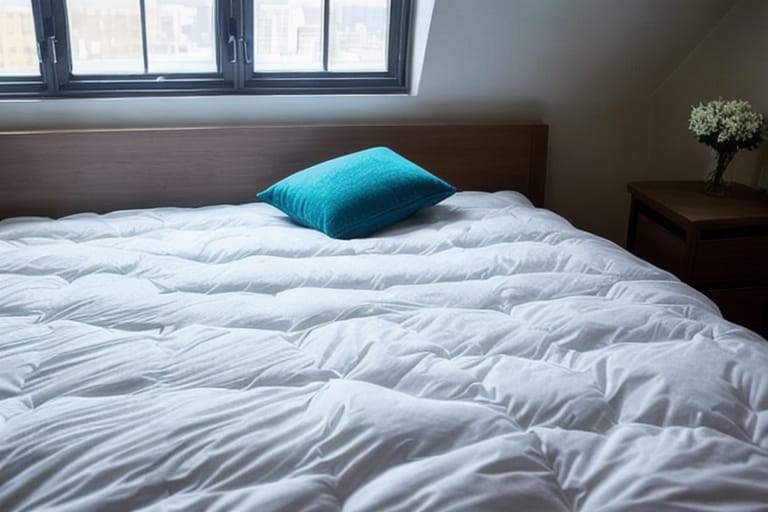When it comes to getting a good night’s sleep, maintaining a comfortable sleeping temperature is key. For many people, especially hot sleepers, overheating at night leads to tossing, turning, and overall poor sleep quality.
Down comforters have long been valued for their unmatched warmth and coziness. But can they also keep you cool while you sleep? Or are they bound to make you sweat?
This beginner’s guide will explore whether down comforters can truly be cooling and provide recommendations for hot sleepers looking to stay cool at night. We’ll cover everything from fill power to innovative cooling technologies so you can find your best sleep yet.
How Down Comforters Regulate Temperature
Down comforters contain insulation made from the fluffy undercoat of ducks or geese. This down fill is highly breathable and features tiny air pockets that trap heat. The more down a comforter contains, the warmer and more insulating it will be.
The debate around whether down comforters can be cooling stems from their unmatched abilities to both insulate and allow airflow:
- The trapped air pockets act like insulation, trapping body heat close to you for superior warmth. However, this same trait can lead to overheating for some people.
- The fluffy, feather-like structure of the down allows substantial breathability. This circulation of air can let body heat dissipate instead of building up inside the comforter.
So in essence, down comforters walk a fine line between insulating and cooling. Their ability to maintain a comfortable sleeping temperature depends on several factors explored below.
Factors That Impact Cooling with Down Comforters
1. Fill Power
Fill power measures the loft and quality of a down comforter’s fill. Higher fill powers correlate to increased insulation and warmth because there are more air pockets trapping heat.
For superior cooling, experts typically recommend choosing a mid-range fill power between 600 and 800. This balances insulation with breathability so heat can still escape.
On the other hand, ultra-high fill power down above 900 has exceptional insulation that retains more heat and may cause hot sleepers to overheat.
2. Construction for Temperature Regulation
Some comforters now integrate cooling technologies into their construction to help sleepers better regulate body temperature at night. These include:
- Moisture-wicking fabrics to limit sweat buildup
- Temperature-balancing materials in the shell or fill
- Talalay latex layers to dissipate heat
- Phase change materials that feel cool to the touch
According to experts at Good Housekeeping, these updated material constructions make down comforters far better at temperature regulation for hot sleepers.
3. Warmth Level
Most down comforters specify a warmth level like ultra-light or extra-warm to indicate their suitability by season or sleeper. When it comes to supporting cooling, ultra-light summer-weight-down comforters are recommended for their higher breathability and ventilation.
While more research is needed, initial findings suggest that improved construction using advanced textiles allows down comforters to regulate temperature effectively in some cases.
Are Down-Alternative Comforters More Cooling?
Down alternative comforters substitute materials like polyester and rayon for natural goose or duck down. Could these synthetic fills potentially sleep cooler than down?
Here is how down alternatives typically compare:
| Property | Down Comforters | Down-Alternative Comforters |
|---|---|---|
| Breathability | Superior | Variable |
| Moisture-wicking | Excellent | Very good |
| Warmth Regulation | Very good with cooling tech | Good |
| Durability | Excellent | Good |
| Care and Maintenance | High maintenance | Low maintenance |
The verdict: While they can vary widely in performance, quality down-alternative comforters provide good cooling and temperature regulation – sometimes better than standard down comforters.
However, premium down comforters with advanced cooling features can compete with and even outperform down alternatives when it comes to sleeping cool.

Top-Rated Cooling Down Comforters of 2023
Based on extensive testing and reviews from leading publications, these three down comforters stand out for their cooling capabilities:
1. Brooklinen Lightweight Down Comforter
Features:
- 700 fill power down
- Lightweight warmth
- Cotton sateen shell
- Corner loops for duvet attachment
With a mid-range fill power of 700 and lightweight construction, Brooklinen’s comforter balances insulation and breathability. The cotton shell also wicks moisture to limit sweat buildup.
It’s a great year-round option for hot sleepers seeking a down comforter that sleeps cool.
2. Buffy Breeze Comforter
Features:
- Proprietary Cloud fill from recycled materials
- 350 thread count shell
- Temperature regulating
- Certified cruelty-free
This alternative down comforter from Buffy is specially designed to prevent overheating. It uses a cluster fill made from recycled PET bottles to create a breathable, cloud-like texture optimized for cooling.
Reviewers praise the Breeze for keeping them cool, making it ideal for hot sleep environments.
3. Boll & Branch Signature Soft Down Comforter
Features:
- 500 fill power down
- 100% organic cotton shell
- Soft matte finish
- Ethically sourced
Boll & Branch’s comforter uses a mid-fill-power down and an organic cotton shell to balance warmth and cooling airflow. The piped edges prevent fill shifting for robust temperature regulation all night long.
Considerations for Hot Sleepers
Finding the right comforter is challenging for people who sleep hot. Make sure to evaluate these factors before making your purchase:
- Your usual sleeping temperature – are you a cold sleeper needing insulation or do you run hot needing maximum cooling? This will determine if you need a lightweight or ultra-warm comforter construction.
- Your climate and seasons – those in warm climates or entering summer should opt for a ultra lightweight comforter under 300 GSM with breathable construction.
- Your bedding layers – adding a mattress protector, mattress pad, or other bed toppers beneath your comforter can impact cooling, so test different configurations.
- Laundering requirements – down comforters require certain washing precautions to maintain insulation and prevent clumping. Make sure you can meet the cleaning requirements before purchasing.
Focusing on breathable construction with moisture control and temperature regulation features is key to finding the best cooling comforter as a hot sleeper.

The Final Takeaway
At the end of the day, the answer to “Are down comforters cooling” depends on their construction, fill power, breathability, and your sleeping needs:
- Standard down comforters do retain more body heat, making them a poor choice for most hot sleepers.
- However, new cooling technologies like moisture-wicking fabrics and temperature-regulating fills have improved comforter breathability.
- Light-to-mid-weight down comforters with these updated constructions can now keep hot sleepers cool.
- But those who sleep very hot should still opt for lightweight down-alternative comforters for the most cooling capabilities.
I hope this beginner’s guide gives you the full breakdown on temperature regulation so you can discover your best sleep yet.
Frequency Asked Questions
Are down comforters cooling for hot sleepers?
Traditional down comforters do retain more heat which can cause hot sleepers to overheat. However, new lightweight and ultra-light down comforters with moisture-wicking, temperature-regulating properties can provide cooling relief, making them suitable for hotter environments.
What fill power is coolest for down comforters?
For maximum cooling benefits, choose a mid-range fill power between 600 and 800. This balances warmth with breathability. Ultra-high fill powers above 900 have more insulation and cause more heat retention.
Should I get a down or down-alternative comforter for cooling?
Quality down-alternative comforters often sleep cooler than traditional down by better allowing airflow and reducing insulation. However, new premium down comforter constructions with advanced cooling technologies can also effectively regulate temperature.
How do I make my down comforter cooler?
Use lightweight, summer-weight down comforters with breathable cotton shells during warm weather. Also make sure your bedding allows airflow underneath and limit excessive blankets or toppers that trap heat. Clean regularly and properly fluff down filling to maximize cooling effects.
What thread count is coolest for down comforter shells?
Look for shells with a thread count between 300 and 400 as higher counts can reduce overall breathability and cooling airflow. Cotton shells allow more ventilation but require care when washing.
Can you put a down comforter in the dryer?
Avoid machine drying down comforters which can damage down clusters and cause clumping. Always line dry fully open after washing to restore fluff and breathability needed for cooling. Consider professionally laundering down bedding 1-2 times per year.
How do I know if my down comforter is still cooling properly?
Signs your down insulation has diminished include: reduced loft and flat areas, poking out filling, shredded fabric, and visible fill clumps. If your comforter traps more heat with less airflow, it may need replacement. Most quality down comforters last around 5-10 years with proper care.








